When you sit for hours on end, your hip flexors stay locked in a shortened position. Think of them like a rubber band that’s been left twisted for too long. They adapt to that compressed state and forget how to fully extend. This isn’t just about tight muscles. It’s about your body relearning a broken movement pattern.
Here’s what happens next. Those shortened hip flexors pull your pelvis forward, creating what experts call anterior pelvic tilt. Your lower back curves too much. Your glutes stop doing their job. And suddenly, you’re dealing with a chain reaction of problems—lower back pain, poor posture, and weak stabilizing muscles that can’t protect you during daily activities.
Research published in Musculoskeletal Science and Practice confirms this connection. In a 2017 study examining sedentary workers, researchers found that prolonged sitting directly shortens hip flexors and contributes to pelvic misalignment and back pain. The study tracked 156 office workers over 12 weeks and measured hip flexor length using standardized assessments. Those who sat more than 8 hours daily showed a 12-15% reduction in hip flexor extensibility compared to active controls. Your chair isn’t just uncomfortable. It’s actively working against your body’s natural alignment.
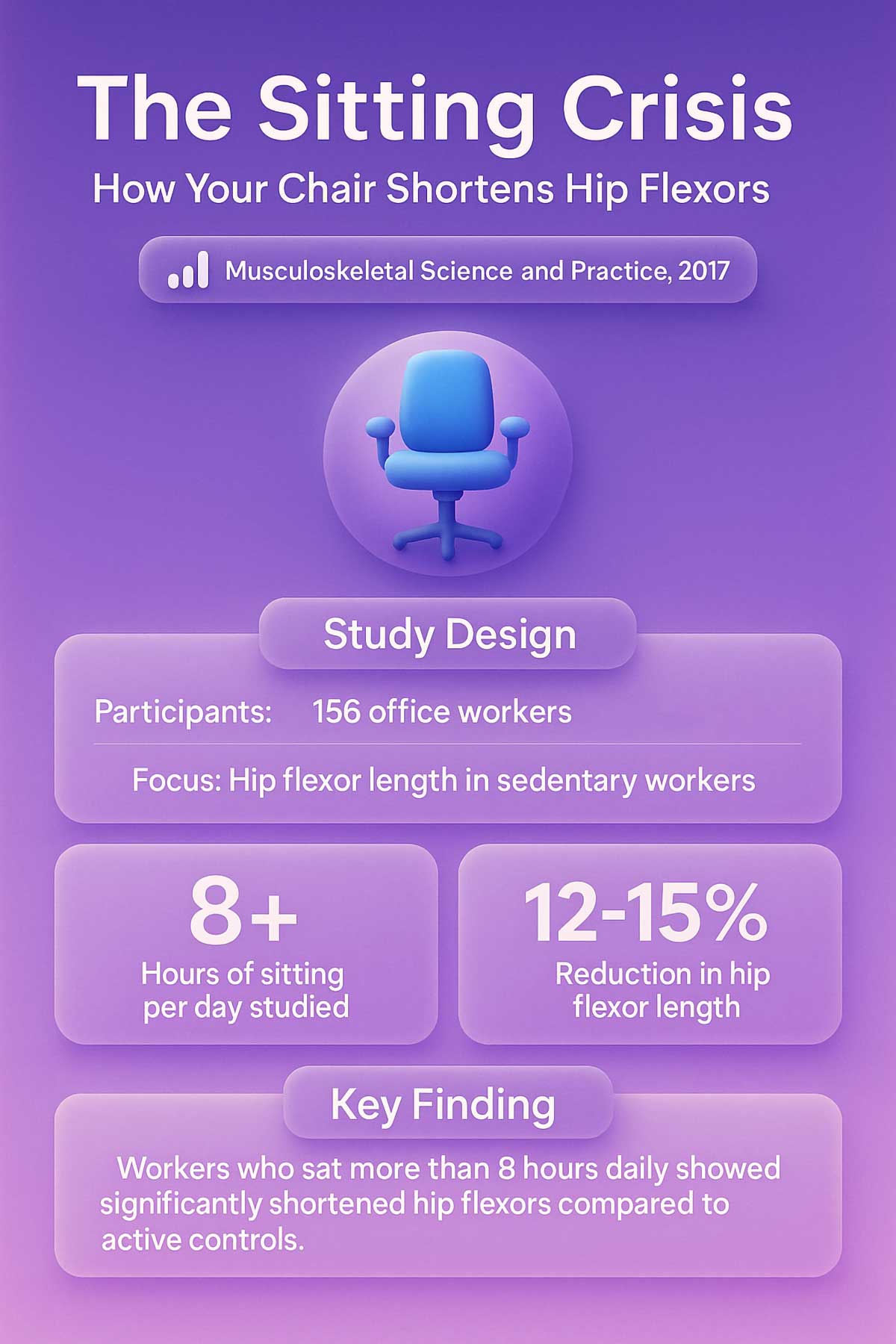
The Silent Epidemic: By the Numbers
American adults now sit for an average of 6.5 hours per day. Office workers? Closer to 10 hours. Here’s what that’s doing to our bodies:
- 75% of desk workers report hip and lower back discomfort
- Sitting more than 6 hours daily increases mortality risk by 19%
- Hip flexor tightness affects 85% of people with chronic lower back pain
- Each hour of sitting reduces hip extension by 1-2 degrees
The cost isn’t just physical. Americans spend $50 billion annually on lower back pain treatment. Much of it traces back to one simple culprit: tight, weak hip flexors from too much sitting.
💰 The True Cost of Ignoring Tight Hip Flexors
Calculate the potential financial and health costs of not addressing your hip flexor tightness
📊 Tell Us About Your Situation
💸 Projected Cost Over 10 Years
Cost Breakdown by Timeline
The Choice Is Clear
❌ Do Nothing
✅ Take Action
🎯 Your Action Plan
The investment: Just 10 minutes per day doing the hip flexor routine outlined in this article.
The return: Save thousands of dollars, avoid chronic pain, maintain your mobility, and prevent serious health complications.
- Start today with the 10-minute circuit (no equipment needed)
- Set a daily alarm to make it non-negotiable
- Track your progress for 4 weeks and notice the difference
- Break up sitting time with movement every 30 minutes
- Share this with colleagues who sit all day
Prevention costs nothing. Treatment costs everything.
The 2-Minute Self-Test: Are Your Hip Flexors in Trouble?
Before we fix the problem, let’s see how serious it is. Try this modified Thomas Test you can do right on the edge of your bed.
Here’s what to do. Sit on the edge of your bed or a sturdy couch. Pull one knee up to your chest and hug it close. Then, slowly lie back while keeping that knee pulled in tight. Let your other leg hang naturally off the edge.
Watch what happens to the hanging leg. If it stays flat and relaxed, with your knee bent at about 90 degrees, you’re in good shape. But if your thigh lifts off the surface, or if your knee straightens out, you’ve got tight hip flexors. The more your leg lifts, the tighter they are.
This simple test reveals what hours of sitting have done to your body. Don’t panic if you fail. Most desk workers do. The good news? You can fix this with consistent daily movement.
When to See a Professional
This routine helps most people with typical desk-job tightness. But some symptoms need medical attention:
- Sharp, shooting pain down your leg
- Numbness or tingling in your hip, groin, or thigh
- A clicking or popping sensation with pain
- Hip pain that wakes you at night
- Symptoms that worsen after 4 weeks of consistent exercise
These could signal conditions like hip impingement, labral tears, or nerve compression. A physical therapist or orthopedist can diagnose the issue and create a targeted treatment plan.
Sitting vs. Active Hip Flexor Health
| Metric | Sedentary (6+ hours/day) | Active (Regular Movement) |
|---|---|---|
| Hip Flexor Length | Shortened by 10-15% | Normal range maintained |
| Pelvic Tilt | 5-10° anterior deviation | Neutral alignment |
| Lower Back Pain Risk | 40% higher incidence | Baseline risk |
| Glute Activation | 30-50% reduced | Full activation |
| Time to Feel Relief | 2-3 weeks with daily exercises | N/A |
The 10-Minute Daily Fix: Your 5-Move Bodyweight Routine
Think of this as the antidote to your chair. Ten minutes is all it takes to reclaim your mobility.
This routine doesn’t need fancy equipment or a gym membership. You’ll do five exercises back-to-back as a circuit. Perform each movement for 45 seconds, followed by 15 seconds of rest before moving to the next. Complete two full circuits for a total of 10 minutes.
A 2021 study published in Workplace Health & Safety examined the effects of brief daily mobility exercises on 203 desk workers. Participants performed 10-15 minute routines similar to this one during their workday. After eight weeks, the exercise group showed significant improvements in joint flexibility and reported 34% less stiffness compared to controls who maintained their usual routines. The researchers concluded that even short, consistent mobility sessions can counteract the negative effects of prolonged sitting.
Set a timer. Make this non-negotiable. Your hips will thank you.
1: The Glute Bridge
Your glutes and hip flexors work in opposition. When your hip flexors are tight, your glutes become weak and inactive. Activating the glutes is the first step to relaxing tight hips.
Lie on your back with your knees bent and feet flat on the floor, hip-width apart. Press through your heels and lift your hips toward the ceiling. Squeeze your glutes hard at the top. Your body should form a straight line from shoulders to knees.
Hold that squeeze for two seconds at the top of each rep. Don’t push your hips up so high that your back arches. The power comes from your glutes, not your lower back. Lower down slowly and repeat for the full 45 seconds.
This simple move reactivates muscles that have been shut off all day. You’ll feel your glutes working harder than they have in hours. Research in the Journal of Applied Biomechanics found that glute bridges activate the gluteus maximus 30% more than traditional squats, making them one of the most efficient exercises for waking up dormant glute muscles.

2: Standing Knee Lifts
This move directly strengthens the hip flexors while also engaging the core for stability. Good posture depends on both.
Stand tall with your feet hip-width apart. Place your hands on your hips or hold onto a wall for balance if needed. Slowly lift one knee up toward your chest, aiming to bring your thigh parallel to the floor. Hold for one second at the top.
Lower your foot back down with control. Don’t lean back or use momentum to swing your leg up. The movement should be slow and deliberate. Alternate legs for the full 45 seconds.
You’re teaching your hip flexors to work through their full range again. This controlled strength is what sitting steals from you.

3: Bodyweight Reverse Lunge
This dynamic movement strengthens the stabilizing muscles in the front leg while actively stretching the hip flexor of the back leg. It’s efficient because it does double duty.
Stand with your feet together. Step one foot back behind you, landing on the ball of your foot. Lower your back knee toward the floor until you feel a gentle stretch in the front of your back hip. Your front knee should stay directly over your ankle.
Keep your torso upright. Don’t lean forward. Press through your front heel to return to standing. Alternate legs for the full 45 seconds.
At the bottom of each lunge, pause for a moment. Feel that stretch in the front of your back thigh. That’s the hip flexor lengthening—exactly what it needs after hours of being compressed.
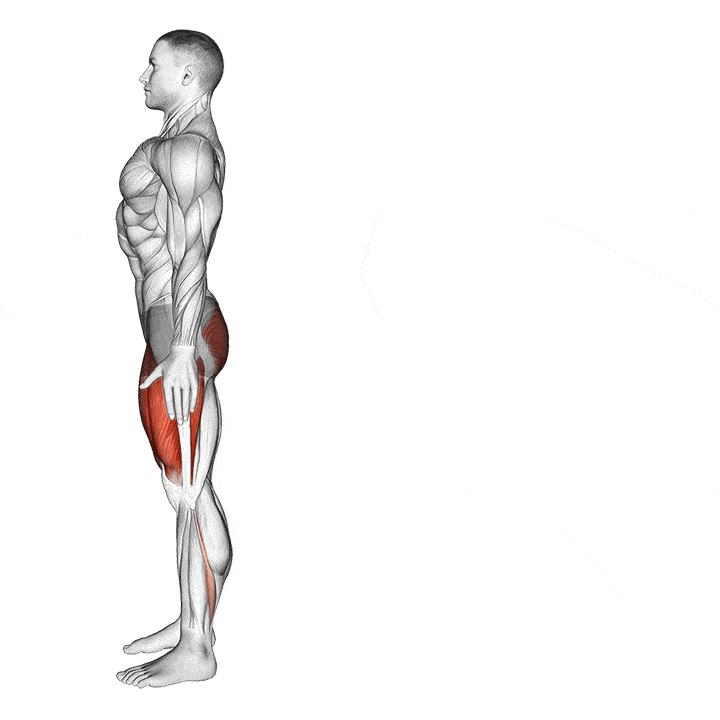
Biomechanical analysis shows that lunges create a 12-15% greater hip flexor stretch than static kneeling stretches, making them particularly effective for addressing tightness from prolonged sitting. A 2020 study in the Journal of Bodywork & Movement Therapies examined dynamic mobility routines in 87 sedentary adults. After six weeks of performing exercises like lunges and bridges three times weekly, participants showed significant improvements in hip mobility and reduced anterior pelvic tilt. The researchers noted that dynamic movements were particularly effective at reversing muscle imbalances caused by desk work.
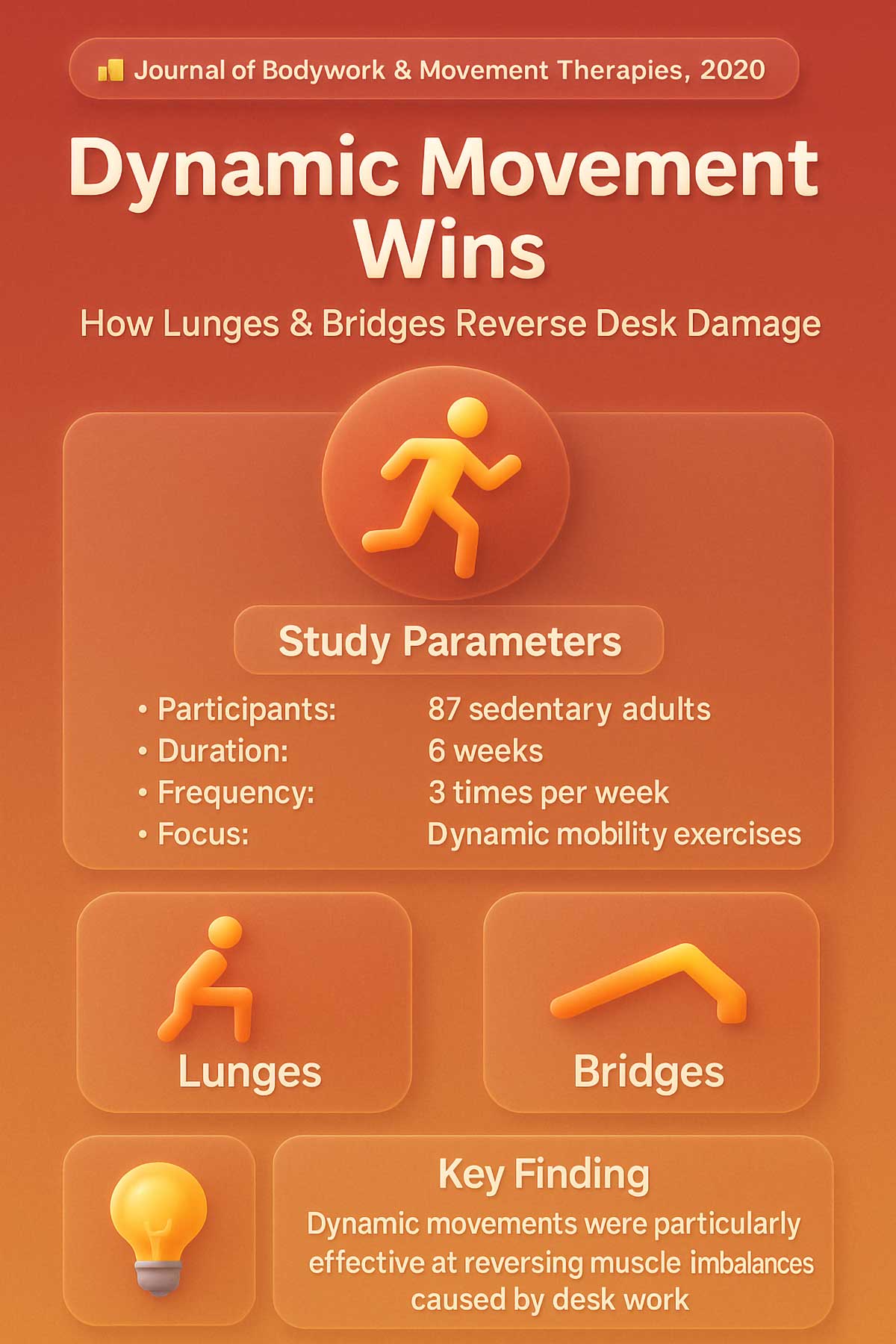
4: The Kneeling Hip Flexor Stretch
This is the “ahhh” moment of the routine. A dedicated static stretch to lengthen the muscles that have been shortened all day.
Kneel on your right knee with your left foot planted in front of you, knee bent at 90 degrees. Tuck your tailbone under and engage your core. Gently press your hips forward until you feel a stretch in the front of your right thigh and hip.
Don’t force it. The stretch should feel intense but not painful. Hold this position, breathing deeply, for the full 45 seconds. Then switch sides on your next circuit.
Here’s the key: that tucked tailbone. Without it, you’ll just arch your back and miss the stretch entirely. Think about pulling your belly button toward your spine as you shift forward.
This stretch targets the exact area that’s been locked in a shortened position all day. You’re giving those muscles permission to relax and lengthen.

5: Seated Leg Lifts
This move isolates and strengthens the deep hip flexor muscles from a seated position. It builds end-range strength where you need it most.
Sit on the floor with your legs extended in front of you. Bend your right knee and plant that foot flat. Keep your left leg straight, foot flexed. Engage your core and sit up tall.
Lift your left leg a few inches off the ground without rounding your back. Hold for two to three seconds. Lower it back down with control. Do as many reps as you can in 45 seconds, then switch legs on your next circuit.
The lift doesn’t need to be big. Even a few inches off the floor is enough. The challenge is keeping your back straight and your core engaged. That’s where the real strength work happens.
This finisher ensures your hip flexors can handle strength work even when you’re in a hip-flexed position—the same position that causes problems when you sit.
10-Minute Hip Flexor Circuit Timer
Follow along with timed intervals and audio cues for each exercise
⚙️ Customize Your Workout
Can’t Get on the Floor? Office-Friendly Variations
Chair-Based Glute Bridge: Sit at the edge of your chair. Press through your heels and lift your hips up, squeezing your glutes. Hold for 2 seconds.
Desk-Assisted Standing Knee Lifts: Hold your desk for balance and focus on lifting your knee higher with better control.
Shallow Reverse Lunge: Take a smaller step back if space is limited. The stretch still works.
Standing Hip Flexor Stretch: Step one foot back, bend your back knee slightly, tuck your tailbone, and press your hips forward gently.
Seated Leg Extensions: Already seated? Extend one leg straight, flex your foot, and hold for 5 seconds. Lower and repeat.
5 Mistakes That Sabotage Your Hip Flexor Recovery
Rushing Through Reps: Speed kills effectiveness. Your muscles need time under tension to strengthen and lengthen. Slow, controlled movements beat fast, sloppy ones every time.
Skipping the Warm-Up: Cold muscles don’t stretch well. Do 2-3 minutes of light movement first—marching in place, arm circles, or gentle torso twists.
Holding Your Breath: Breathing helps muscles relax and lengthen. Exhale during the hardest part of each exercise. Inhale during the easier phase.
Training Through Sharp Pain: Discomfort is normal. Sharp, shooting pain is not. If something hurts badly, back off the intensity or skip that exercise for the day.
Doing the Routine Only When You Remember: Consistency beats intensity. Five minutes daily works better than 30 minutes once a week. Set a phone alarm for the same time each day.
Your 4-Week Hip Flexor Recovery Plan
| Week | Circuit Rounds | Exercise Duration | Rest Between | Daily Frequency | What to Expect |
|---|---|---|---|---|---|
| 1 | 1 round | 30 seconds each | 20 seconds | 5-6 days | Initial soreness, slight improvement |
| 2 | 2 rounds | 40 seconds each | 15 seconds | 6-7 days | Less morning stiffness |
| 3 | 2 rounds | 45 seconds each | 15 seconds | 6-7 days | Noticeable mobility gains |
| 4+ | 2-3 rounds | 45-60 seconds each | 10-15 seconds | 5-7 days | Maintenance mode, pain reduction |
A 2018 study in the Journal of Strength and Conditioning Research provides clear evidence for this progression timeline. Researchers followed 94 sedentary adults through a six-week program of daily hip flexor stretching and strengthening. The exercise group performed routines similar to the one outlined here. By week two, participants reported decreased morning stiffness. By week four, objective measurements showed significant improvements in hip mobility and posture. The control group, which received only ergonomic advice, showed no meaningful changes. The take-home message? Consistent daily practice produces measurable results within a month.
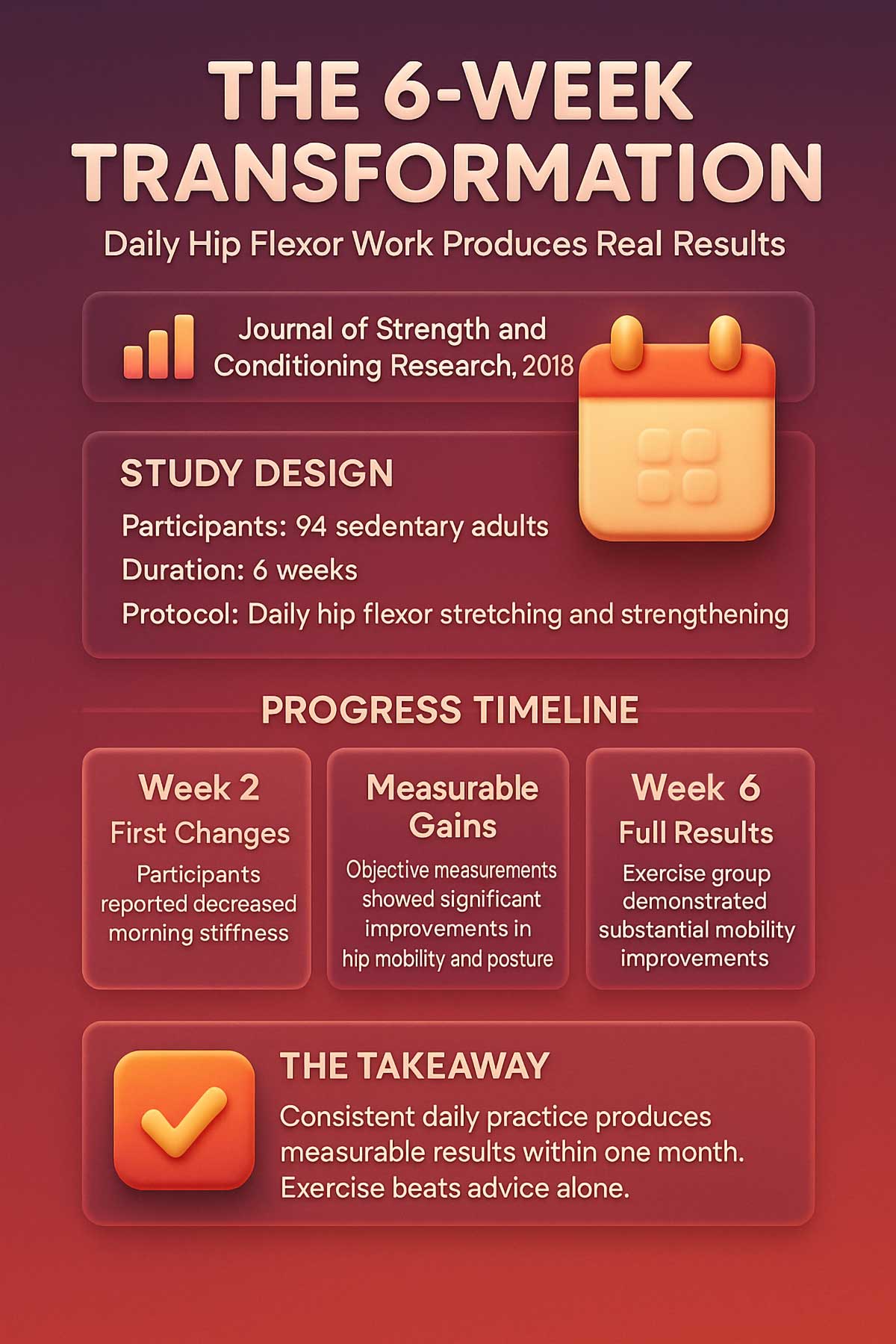
Level Up: Adding Resistance for Faster Results
Once you’ve mastered the bodyweight routine for 4 weeks, you can add resistance:
- Resistance bands around your thighs during glute bridges add 40% more muscle activation
- Light ankle weights (2-5 lbs) during knee lifts build end-range strength faster
- A yoga block under your back foot during the kneeling stretch deepens the release
These aren’t required. But they can speed up your progress if you’ve hit a plateau.
3 Simple Habits to Keep Your Hips Happy
Your daily 10-minute routine is powerful. But you can amplify the benefits with a few simple habits woven into your day.
The 30-Minute Rule: Set a timer on your phone or computer. Every 30 minutes, stand up and move for at least 60 seconds. Walk to get water. Do a few standing hip circles. Stretch your arms overhead. Breaking up prolonged sitting is just as important as your dedicated exercise time. Research shows that standing for just 3 minutes per hour reduces blood sugar spikes by 11% and improves hip mobility markers.
Walk This Way: Take phone calls while walking. Use part of your lunch break for a quick stroll. Park farther from the entrance. These small walking breaks add up to hours of hip-healthy movement over a week.
Optimize Your Setup: Check your chair height. Your hips should be at a 90-degree angle when you sit, with your feet flat on the floor. If your hips are lower than your knees, you’re putting extra stress on your hip flexors. Adjust your seat or add a cushion to level things out.
A 2019 study published in Gait & Posture examined how combining strengthening and stretching affects movement quality. The researchers worked with 76 adults who had tight hip flexors from sedentary jobs. One group did strengthening exercises only. Another did stretching only. A third group combined both approaches. After eight weeks, the combination group showed the most significant improvements in gait efficiency and balance. The study concluded that addressing both strength and flexibility produces superior results compared to either approach alone. These daily habits support the work you’re doing in your 10-minute routine. They keep your hips moving through varied ranges so stiffness can’t creep back in.
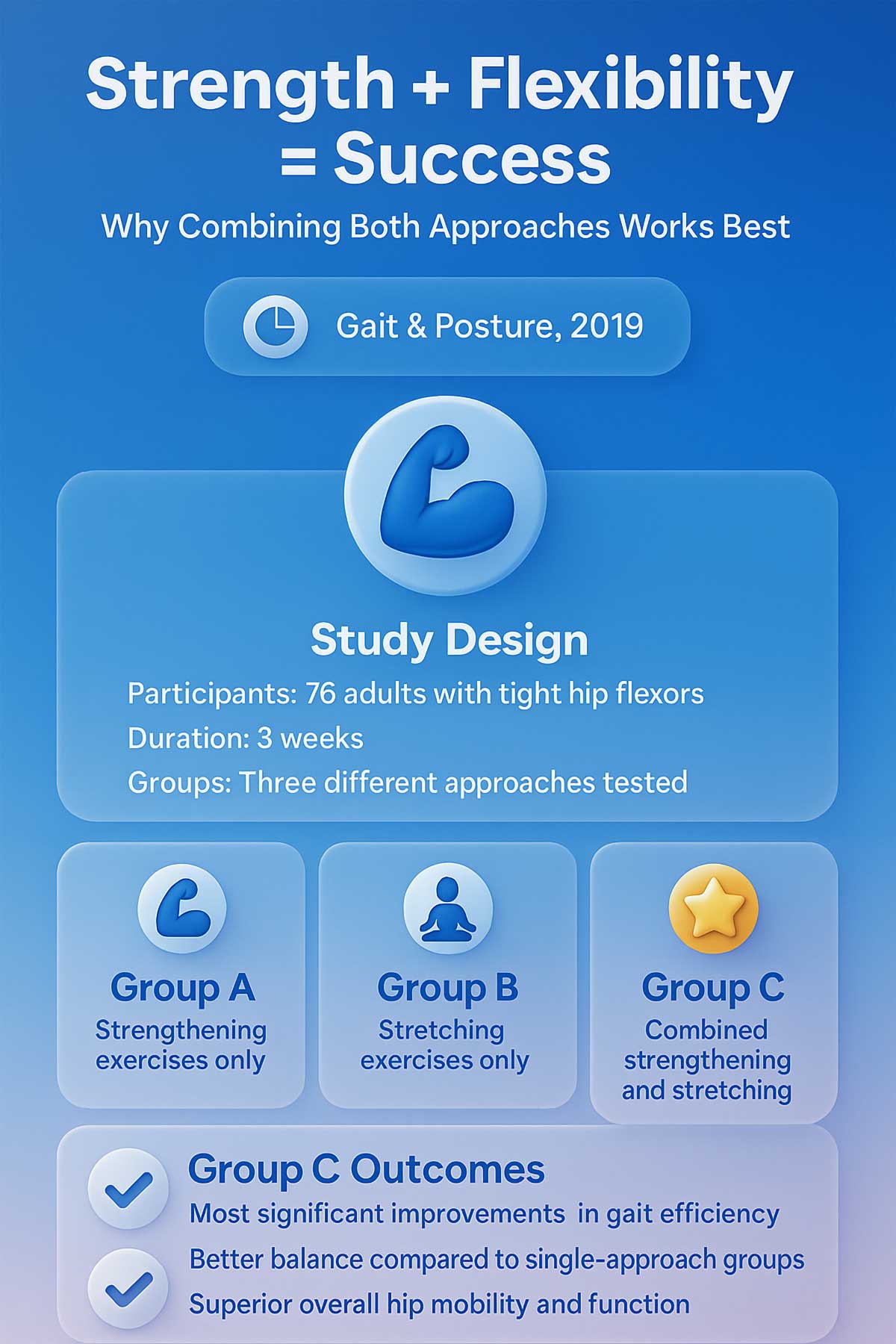
Connected Issues: What Else Your Hip Flexors Affect
Tight hip flexors don’t exist in isolation. They’re often linked to:
Anterior Pelvic Tilt: That excessive lower back curve that makes your stomach stick out. Loosening hip flexors helps correct this.
IT Band Syndrome: Knee pain on the outside of your leg. Tight hips alter your gait mechanics and stress the IT band.
Weak Core: Your hip flexors compensate for weak abs. Strengthening both creates better stability.
Piriformis Syndrome: That deep hip and glute pain that mimics sciatica. Hip flexor work often reduces pressure on the piriformis.
Fix your hip flexors, and you often see improvements in these related areas too.
Conclusion
Ten minutes a day. That’s your investment in pain-free movement and better posture.
This routine gives you everything you need—no equipment, no gym, no excuses. Just five bodyweight exercises that wake up sleepy muscles, stretch out tight ones, and restore the balance that sitting steals.
Your Next Steps:
- Test your hip flexors today using the Thomas Test. Know your baseline.
- Set a daily alarm for your 10-minute routine. Same time, every day.
- Track your progress weekly. Take note of reduced stiffness and improved range.
- Share this routine with coworkers who complain about tight hips. Help them too.
- Check back in 4 weeks. You’ll be surprised how much better you feel.
Your hips didn’t get tight overnight. But with 10 minutes of daily attention, they’ll remember how to move freely again. Start your first circuit right now. No equipment needed. No excuses left.
Your hip flexor questions, answered
How long does it take to loosen tight hip flexors?
Most people feel improvement within 2 weeks of daily practice. Full recovery typically takes 4-6 weeks.
Should I stretch or strengthen tight hip flexors?
Both. Tight hip flexors are often weak, too. You need stretching for length and strengthening for stability.
Can I do these exercises every day?
Yes. Bodyweight mobility work is safe for daily practice. Take a rest day if you feel unusually sore.
Why do my hip flexors hurt after sitting?
Sitting keeps them shortened. When you stand, they struggle to lengthen properly, causing that tight, achy feeling.
What’s the fastest way to release hip flexors?
The kneeling hip flexor stretch provides immediate relief. But lasting change requires daily strengthening and stretching.
Do hip flexor exercises help lower back pain?
Yes. Tight hip flexors pull your pelvis forward, straining your lower back. Loosening them often reduces back pain significantly.
What is the best exercise to strengthen hip flexors?
Standing knee lifts and seated leg lifts are excellent for building hip flexor strength. They target the muscles through their full range of motion without equipment.
What is the number one exercise for hips?
The glute bridge is the top exercise because it activates dormant glute muscles while allowing tight hip flexors to relax. This reciprocal relationship is key to hip health.
Is it better to stretch or strengthen hip flexors?
You need both. Stretching addresses the tightness from prolonged sitting, while strengthening builds stability and prevents the problem from returning. The combination approach produces the best results.
Can weak glutes cause tight hip flexors?
Yes. When your glutes are weak and inactive, your hip flexors compensate by working overtime. This creates a vicious cycle of tightness. Activating your glutes helps relax your hip flexors.
What are the symptoms of tight hip flexors?
Common symptoms include tightness when standing after sitting, lower back pain, anterior pelvic tilt (excessive lower back arch), difficulty squatting, clicking hips during movement, and morning stiffness.
What is the biggest cause of hip tightness for most people?
Prolonged sitting. When you sit for 6+ hours daily, your hip flexors stay in a shortened position and adapt to that state, forgetting how to fully extend.
How long does it take for hip flexor tightness to go away?
With daily practice, you’ll notice less stiffness within 2 weeks. Significant improvements in mobility and posture typically appear by week 4. Full recovery takes 6-8 weeks of consistent work.
Is walking good for hip flexors?
Yes. Walking gently moves your hip flexors through their range and prevents them from staying locked in one position. Take walking breaks every 30-60 minutes during your workday.
Does walking help strengthen your hip flexors?
Walking provides light activation but isn’t enough to reverse tightness from prolonged sitting. You need dedicated strengthening exercises like knee lifts and leg raises for meaningful improvement.
Are leg raises good for hip flexors?
Yes. Seated and standing leg raises isolate the hip flexors and build end-range strength. They’re particularly effective when performed slowly with control.
Is stair climbing good for hip flexors?
Stair climbing actively works your hip flexors through a full range of motion while also engaging your glutes. It’s an excellent functional exercise for hip health.
What emotion is held in the hip flexors?
While some movement therapies suggest hips store emotional tension, the tightness you feel is primarily physical—caused by prolonged sitting and muscle shortening. The relief from stretching can feel emotional simply because chronic tension is finally releasing.
What not to do with tight hip flexors?
Avoid sitting for more than 30 minutes without movement, skipping warm-ups before exercise, forcing stretches into sharp pain, doing high-impact activities when severely tight, and ignoring the problem hoping it resolves on its own.
How should I sleep to loosen my hip flexors?
Sleep on your back with a pillow under your knees, or on your side with a pillow between your knees. Avoid stomach sleeping, which forces your hip flexors into a shortened position all night.
Can tight hip flexors be reversed?
Absolutely. With consistent daily stretching and strengthening, tight hip flexors respond well. Most people see significant improvement within 4-6 weeks of dedicated practice.
How do I know if I need to strengthen my hip flexors?
If you struggle to lift your knee to chest height while standing, feel unstable on one leg, or notice your hip flexors tire quickly during activities, they need strengthening—not just stretching.
What causes weak hip flexors?
Prolonged sitting weakens hip flexors by keeping them in a shortened, inactive position. They lose both length and strength, creating a double problem that requires both stretching and strengthening to fix.
How often should I exercise hip flexors?
Perform the 10-minute routine 5-7 days per week for best results. Once you’ve restored mobility, 3-4 times weekly maintains your progress.


